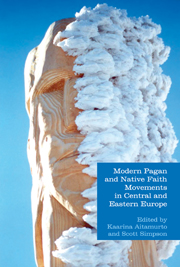Book contents
- Frontmatter
- Contents
- Contributors
- 1 Introduction: Modern Pagan and Native Faith Movements in Central and Eastern Europe
- Part I Overviews
- Part I Country Studies
- 6 Contemporary Paganism in Lithuanian Context: Principal Beliefs and Practices of Romuva
- 7 The Dievturi Movement in Latvia as Invention of Tradition
- 8 Polish Rodzimowierstwo: Strategies for (Re)constructing a Movement
- 9 Ukrainian Paganism and Syncretism: “This Is Indeed Ours!”
- 10 Russian Rodnoverie: Six Portraits of a Movement
- 11 Czech Neopagan Movements and Leaders
- 12 Neopaganism in Slovenia
- 13 Bulgarian Society and the Diversity of Pagan and Neopagan Themes
- 14 Romanian Ethno-Paganism: Discourses of Nationalistic Religion in Virtual Space
- 15 Neopaganism in Hungary: Under the Spell of Roots
- 16 Neopaganism in the Mari El Republic
- 17 A Neopagan Movement in Armenia: The Children of Ara
- Part III Thematic Studies
- Bibliography
- Index
10 - Russian Rodnoverie: Six Portraits of a Movement
from Part I - Country Studies
- Frontmatter
- Contents
- Contributors
- 1 Introduction: Modern Pagan and Native Faith Movements in Central and Eastern Europe
- Part I Overviews
- Part I Country Studies
- 6 Contemporary Paganism in Lithuanian Context: Principal Beliefs and Practices of Romuva
- 7 The Dievturi Movement in Latvia as Invention of Tradition
- 8 Polish Rodzimowierstwo: Strategies for (Re)constructing a Movement
- 9 Ukrainian Paganism and Syncretism: “This Is Indeed Ours!”
- 10 Russian Rodnoverie: Six Portraits of a Movement
- 11 Czech Neopagan Movements and Leaders
- 12 Neopaganism in Slovenia
- 13 Bulgarian Society and the Diversity of Pagan and Neopagan Themes
- 14 Romanian Ethno-Paganism: Discourses of Nationalistic Religion in Virtual Space
- 15 Neopaganism in Hungary: Under the Spell of Roots
- 16 Neopaganism in the Mari El Republic
- 17 A Neopagan Movement in Armenia: The Children of Ara
- Part III Thematic Studies
- Bibliography
- Index
Summary
Among Western Pagans, there is a joke: if you ask ten Pagans you will get eleven answers. This also aptly portrays Rodnoverie, the Russian movement of the followers of the pre-Christian Slavic spirituality. Therefore, even though some ritual and doctrinal uniformization has taken place within Rodnovers during the last decade, it is difficult to draw any general picture of what Rodnoverie beliefs are, what kind of background Rodnovers usually have or what kind of social views they attach to their religiosity.
Such differences have been addressed in earlier studies, but they usually focus on the ideological differences between publications. What seems to be missing is a grassroots perspective of the Rodnoverie believers which could make sense of the contradictory features. As with some studies of similar Pagan movements, we felt that general surveys of the Russian organizations do not fully capture the richness of the religion as it is lived by its adherents. Thus the aim of this article is to provide a contextual view by presenting six case studies.
The narratives presented in this chapter are based on people whom we have met in the course of our fieldwork, but the cases that are presented are composites of two to four individuals. The stories illustrate some of the backgrounds of Rodnovers, the paths by which they arrived at Rodnoverie, and some of the changes that have taken place in the movement over the past twenty years. These examples introduce different ways of understanding Rodnoverie and some of the common viewpoints within the movement.
- Type
- Chapter
- Information
- Publisher: Acumen PublishingPrint publication year: 2013



